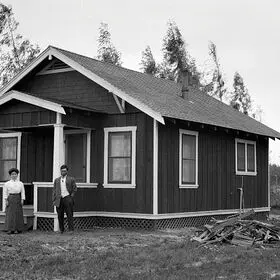Day (and Sites) of Remembrance: The Anniversary of Executive Order 9066

photo by: Library of Congress, LC-USZ62-34565
Executive Order 9066, which was issued shortly after the attack on Pearl Harbor, forced Japanese-Americans into internment camps.
On February 19, 1942, President Franklin Delano Roosevelt signed Executive Order 9066, authorizing the military to relocate more than 120,000 women, men, and children of Japanese ancestry living on the West Coast to desolate internment camps scattered across the country. Entire communities were uprooted as American citizens were forced by their own government to pack their possessions in two suitcases and leave their friends, businesses, and homes behind.
The Panama Hotel was the center of a vibrant Seattle neighborhood when, on that fateful day, first one tenant and soon many more sought permission to store their belongings in the basement. Still filled with the possessions of families who never returned to claim them, the hotel’s basement conveys the confusion and haste in which families were forced to pack up, unsure if they would ever be back.
More than 1,000 miles to the south, Huntington Beach’s Historic Wintersburg also stands as it did more than a century ago. The six now-vacant structures on site are the surviving remnants of Wintersburg Village, once a thriving farm community where Japanese-American families lived, worked, and worshipped. With the signing of EO9066, most of the Wintersburg community was taken to the Poston War Relocation Center, deep in the Arizona desert.
National Treasures: Panama Hotel

The Panama Hotel in Seattle conveys a powerful sense of time and place from an often-overlooked period of American history.
National Treasures: Historic Wintersburg

Historic Wintersburg honors the Japanese-American experience and the early pioneers who built communities in Southern California.
Both the Panama Hotel and Historic Wintersburg are remnants of the historic events that rocked Pacific Coast communities, leaving a painful legacy of incarceration and discrimination. Today, we reflect upon valuable lessons from these places as we strive to uphold our values, often surrounded by vicious rhetoric in our public discourse.
The passage of time and the work of new generations of families and neighbors have allowed a positive light to shine on these places once again. World War II cut deep into the fabric of Seattle’s Nihonmachi and Wintersburg Village, and while both places changed dramatically in the wake of the war, neither is defined by it. Both are resuming their roles as prominent gathering places for their neighborhoods, and are testaments to the resilience of their communities.
Today we have the tremendous privilege to help continue that legacy, to restore these important places so that they can serve as neighborhood anchors and living lessons for neighbors and visitors alike of the fragility of civil liberties and the value of community.
photo by: Library of Congress, LC-USZ62-23602
This store was owned by a Japanese-American forcibly relocated to an internment camp. After the owner's eviction, an "I am an American" sign was placed on the storefront.


